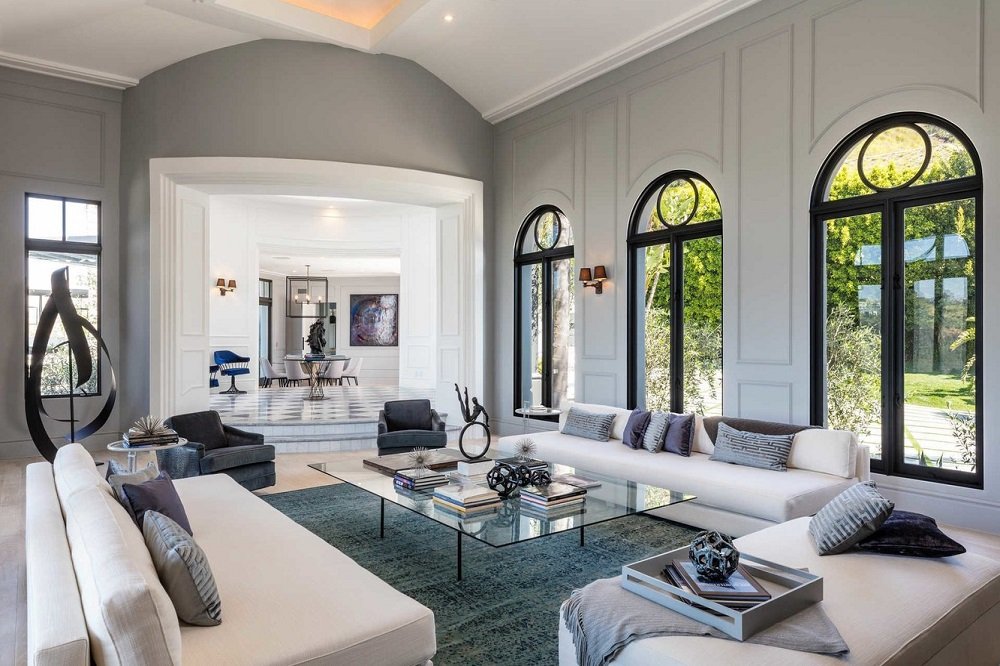How to Style Your New Couch: A Guide to Throws, Cushions, and Layout
Congratulations! You’ve found the perfect centrepiece for your living room. Whether you’ve just taken delivery of a plush new sectional or a sleek, modern loveseat, the journey to creating your dream lounge is only half complete. A couch is more than just a place to sit; it’s a statement of style, a hub for connection, and the foundation upon which your entire lounge decor is built.
But a beautiful couch on its own can feel a little… bare. It’s the accessories—the artful drape of a throw, the strategic placement of cushions, and the overall layout—that transform it from a simple piece of furniture into a warm, inviting, and magazine-worthy sanctuary.
This guide is designed to walk you through the final, crucial steps of styling your new couch. We’ll delve into the world of textures, colours, and arrangements, helping you create a space that is not only beautiful but also uniquely yours. And if you’re still on the hunt for the perfect foundation, remember to explore our exquisite collection of couches for sale in Gauteng.
Part 1: The Foundation – Choosing the Right Couch
Before we dive into styling, it’s essential to acknowledge that the best results start with the right canvas. The style, size, and colour of your couch will dictate your accessory choices.
- Size & Scale: A large, L-shaped sectional requires a different styling approach than a petite two-seater. Ensure your couch fits the room’s proportions; it should allow for easy movement and not overwhelm the space.
- Style: Is your couch a mid-century modern masterpiece with clean lines, a traditional rolled-arm Chesterfield, or a deep, casual-comfy modular? Its inherent style guides your accessory choices. A modern couch might call for minimalist, geometric cushions, while a traditional one can handle richer patterns and tassels.
- Colour: A neutral-coloured couch (beige, grey, cream, or navy) is a versatile canvas, allowing you to be bold and experimental with your cushions and throws. A bold, coloured couch (emerald green, mustard yellow, or terracotta) often works best with more complementary or tonal accessories to create a cohesive look.
If you haven’t found your perfect match yet, our showrooms offer a wide range of sofas for sale to suit every taste and budget. Discover options perfect for your space with our curated selections for couches for sale in Randburg, couches for sale in Soweto, and across the region with our main collection of couches for sale in Johannesburg and Pretoria.
For more on selecting the perfect sofa frame, this external sofa buying guide offers excellent foundational advice: DFS Sofa Buying Guide.
Part 2: The Art of the Cushion
Cushions are the jewellery of your couch. They add personality, comfort, and a vital pop of colour and texture.
The “Rule” of Odd Numbers
Start with an odd number of cushions—three, five, or even seven—for a look that feels naturally balanced and collected rather than overly symmetrical and stiff. On a standard three-seater couch, three cushions is a great starting point.
The Layering Principle: Size, Shape, and Texture
The magic happens in the mix. Don’t use five identical cushions. Instead, create depth and interest by combining different elements:
- Sizes: Pair larger standard or lumbar (rectangular) cushions with smaller square ones. A 20″ x 20″ cushion paired with an 18″ x 18″ and a lumbar pillow creates instant visual hierarchy.
- Shapes: Don’t be afraid to introduce a round bolster or a quirky kidney-shaped cushion to break up the monotony of squares and rectangles.
- Textures: This is where your couch comes to life. Combine a variety of fabrics like:
- Chunky knit for a cosy, rustic feel.
- Silk or velvet for a touch of luxury and shine.
- Linen or cotton for a casual, breathable, and relaxed vibe.
- Leather or faux fur for a bold, textural statement.
The Colour and Pattern Play
Your colour scheme will set the mood for the entire room.
- Monochromatic: Use varying shades of one colour (e.g., slate grey, charcoal, and silver) with different textures to create a sophisticated, calm, and cohesive look.
- Complementary: Choose colours opposite each other on the colour wheel (e.g., blue and orange, navy and mustard) for a vibrant, energetic feel.
- Analogous: Use colours that sit next to each other on the colour wheel (e.g., blue, green, and teal) for a harmonious and serene scheme.
- Pattern Mixing: The key to mixing patterns is to vary their scale. Combine a large-scale pattern (e.g., a big floral) with a medium-scale pattern (e.g., a stripe) and a small-scale pattern (e.g., a subtle geometric or polka dot). Keep them within the same colour family to tie them together seamlessly.
For a deeper dive into design philosophies that can inform your choices, this resource is invaluable: Therap Interior Design Philosophies.
Part 3: The Cosy Factor – Draping the Perfect Throw
A throw blanket is the ultimate symbol of comfort and relaxation. It invites you to curl up with a good book and adds a layer of softness that makes a room feel lived-in and loved.
Choosing Your Throw
Consider the material based on the season and the feel you want to achieve:
- Wool or Chunky Knit: Perfect for winter, adding immense texture and warmth.
- Cotton or Lightweight Linen: Ideal for summer, providing a light layer without overheating.
- Faux Fur or Sherpa: The epitome of luxury and cosiness, great for creating a focal point.
- Cashmere or Merino Wool: For an ultra-soft, indulgent touch.
The Art of the Drape
A throw should look casually elegant, not neatly folded and placed. The goal is to make it look effortlessly placed, as if it just landed there.
- The Simple Drape: Fold the throw in half lengthwise and drape it over one arm of the couch or the back corner. This is clean, simple, and effective.
- The Casual Scrunch: Loosely fold the throw and then scrunch it slightly before placing it over an arm or the back. This creates a more relaxed, informal look.
- The Bench Drape: If your couch has a bench-like seat (no crevice between cushions), you can neatly fold the throw and drape it over the centre of the seat, allowing the ends to cascade onto the floor on either side.
- The Basket Companion: For a tidier look, fold your throw neatly and place it in a beautiful basket beside the couch. It’s practical, stylish, and always within reach.
Part 4: Mastering the Layout – It’s All About Flow
How your couch is positioned in the room is just as important as how it’s dressed. The right layout promotes conversation, defines the space, and ensures a harmonious flow.
Focal Point Facing
Arrange your couch to face the room’s natural focal point. This is most often the television, but it could also be a fireplace, a large window with a beautiful view, or a significant piece of art. This creates an intuitive and functional arrangement.
Conversation-Friendly Grouping
The primary function of a living room is to facilitate connection. Arrange your seating (your couch and accompanying chairs) in a U-shape or an L-shape to encourage face-to-face conversation. No one should have to crane their neck to talk to someone else. Aim for a distance of about 2-3 metres between seating pieces to feel intimate but not cramped.
Float it Away from the Walls
While pushing your couch flat against the wall is often the default, especially in smaller rooms, “floating” your sofa away from the walls can make a room feel larger and more dynamic. Even a few inches of space can create a sense of airiness and make the couch feel like an intentional island of comfort.
The Importance of a Rug
A rug is the anchor that grounds your entire seating area. Your couch should be connected to the rug. The front legs of all your seating pieces should rest on the rug. This visually ties the furniture together and defines the conversation zone within the larger room.
Part 5: Bringing It All Together – A Styling Checklist
Ready to style? Follow this step-by-step checklist:
- Start Fresh: Remove all existing cushions and throws.
- Position the Couch: Ensure your couch is in its ideal layout within the room.
- Anchor with the Largest Cushions: Place your two largest cushions in the far corners of the couch.
- Layer In: Add your next largest cushions in front of or next to the first ones.
- Add Accents: Place your smallest or most uniquely shaped cushions last, in the front where they can shine.
- Drape the Throw: Choose your method and casually place your throw blanket.
- The Final Touch: Add a tray with a small vase, a candle, or a couple of books on one end of the couch for a polished, lived-in look.
- Step Back: Walk to the doorway and assess the overall balance. Make small adjustments as needed.
For inspiration on some of the best couch designs on the market, have a look at this Forbes roundup: Forbes Best Couches.
Conclusion: Your Personal Sanctuary Awaits
Styling your new couch is not about rigid rules; it’s about expressing your personal style and creating a space that feels authentically you. It’s a process of layering, experimenting, and adjusting until you achieve that perfect balance of comfort and style. Don’t be afraid to play with different combinations seasonally—lighter linens for summer, richer wools for winter.
Remember, the best-designed rooms are those that are lived in and loved. So, arrange those cushions, drape that throw, and get ready to enjoy your beautifully styled sanctuary.
And remember, a stunning couch is just the beginning. To complete your bedroom oasis to match your newly styled lounge, be sure to check out our partners, leading Gauteng bed manufacturers: Beds and All Bed Manufacturers.
For a final, detailed checklist on what to look for in a sofa’s construction and comfort, this guide is a fantastic resource: MCW Sofa Buying Guide.




